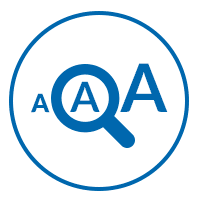 | ||
Similar Schlachter Bible, Scofield Study Bible III, Everything Easy Large‑Pri, Darby Bible, Lord Edgware Dies | ||
Large-print (also large-type or large-font) refers to the formatting of a book or other text document in which the typeface (or font), and sometimes the medium, are considerably larger than usual, to accommodate people who have poor vision. Often public special-needs libraries will stock large-print versions of books, along with versions written in Braille.
Contents
Among librarians Large Print is defined as print that is at least 18 points in size.
History
Large Print book publishing in English began in 1964 in Leicester, England when Frederick Thorpe, a retired book and magazine distributor, decided to meet the needs of elderly poor-sighted readers by reprinting older classic books in editions about twice the physical size of the original book. The type inside was enlarged to about twice the size of the original printing. The books were given plain dustjackets with type only, color-coded to indicate categories like mysteries (black), general fiction (red), romances (blue), Westerns (orange) and so forth. These editions met the need but were difficult for frail elderly readers to handle because they were oversize.
In 1969 Thorpe's company, Ulverscroft, began to retypeset the books in 16 point type and print them in normal-sized bindings, again with color-coded plain jackets. This change greatly increased the acceptance of Large Print in public libraries. Thorpe himself became a Large Print ambassador, travelling around the English-speaking world promoting the acquisition of Large Print books for seniors.
Today Large Print editions of some current books are published simultaneously with regular print editions by their publishers and usually feature the same full-colour jackets and jacket design. Many, if not most public libraries in the English-speaking world have Large Print sections and most bookstores do carry some Large Print editions.
Publishing standards
The American National Association for Visually Handicapped (NAVH) provides the NAVH Seal of Approval to commercial publishers in the US, for books that meet their large print standards. (Lighthouse International acquired NAVH in 2010).
The standards call for:
Readable fonts
For many people with visual impairment enlarging the type is not enough. Fonts designed for readability make it easier to distinguish one character from another. Some characteristics of such fonts are:
Examples of more-easily read fonts are APHont, Antique Olive, Helvetica, Tahoma, and Verdana. APHont was developed for the non-profit AmericanPrinting House for the Blind. They also make it available as a free download for individual use by those with vision problems.
Recent developments
Since 2005 some companies, notably ReadHowYouWant, have begun offering a variety of font sizes for Large Print books. This allows readers to choose the font that best suits them when purchasing a book. The font size usually varies from more regular sizes (11 and 13 point fonts) through to large (16 to 20 point fonts) and Super Large (up to 48 point fonts). These books can also be purchased in Bold.
